Community tanks done right are one of my favourite types of aquariums to just sit, watch, and admire.
In this guide, I’ll introduce you to different community fish and invertebrate, how they occupy different levels of the water column, feed and interact with each other.
By the end of this article you’ll be able to create a harmonious community tank that flourishes with life and color.
1. Chili Rasboras (Boraras brigittae)
- Size: 0.5-0.75 inches (1.25-2 centimeters)
- Minimum tank size: 5 gallon (19 liter)
- Care level: easy
- Temperament: peaceful
- Schooling/shoaling fish: yes, needs to be in a group of 5 or more. For these fish, it’s the more, the merrier.
- Temperature: 68°-82°F (20°-28°C)
- Diet: carnivorous
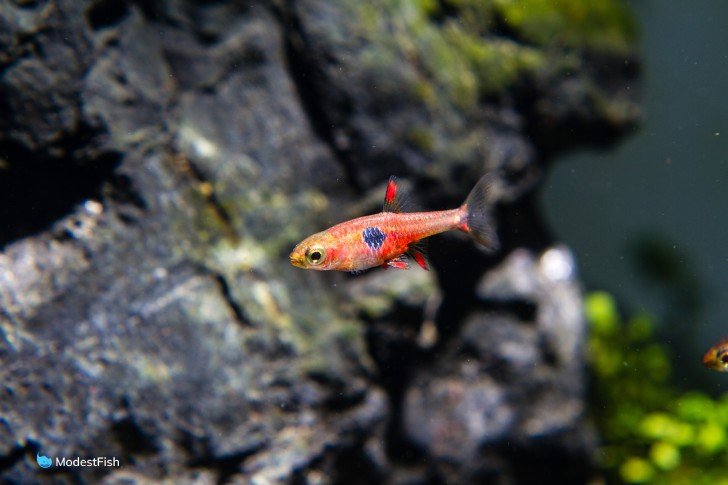
These tiny fish pack a big punch. Chili rasboras are a vibrant red and are some of the cutest fish in the aquarium trade.
They absolutely need to be kept in a group of five or more.
I love the way these fish move. They do this super fast darting thing sometimes that’s so fast it looks like they’re teleporting.
Chili rasboras are a slim-bodied fish that are bright red with a small black line that runs from their dorsal fin to their tail.
Since this species is so small, they can only be kept with other relatively tiny species, like neon tetras, glowlight tetras, etc..
Even among really peaceful fish, if one fish can easily swallow a tank mate, the little fish will likely get eaten.
2. Harlequin Rasboras (Trigonostigma heteromorpha)
- Size: 2 inches (5 centimeters)
- Minimum tank size: 20 gallon (76 liter)
- Care level: easy
- Temperament: peaceful
- Schooling/shoaling fish: yes, should be kept in a group of 5 or more
- Temperature: 75°-82°F (24°-28°C)
- Diet: omnivore
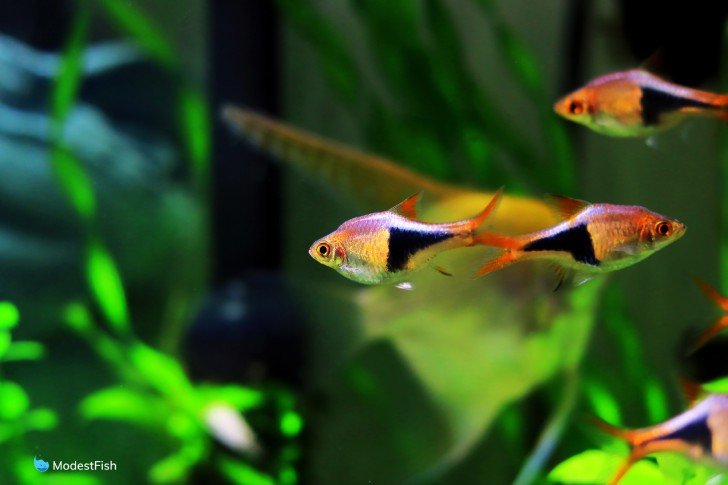
I am particularly fond of this species. I love their sunset gold/copper coloration. These little guys are just gorgeous.
They’re a deep chested little fish with a coppery body marked on either side by a mutton chop-shaped brown marking.
I think they especially make a great contrast to species like neon tetras, black skirt tetras or guppies.
Harlequin rasboras need a group to feel secure. They’re not a great directional schooler, but they are very social.
3. Black Skirt Tetra (Gymnocorymbus ternetzi)
- Size: 3 inches (7.5 centimeters)
- Minimum tank size: 30 gallon (113 liter)
- Care level: easy
- Temperament: mostly peaceful but might fin nip long finned species
- Schooling/shoaling fish: yes, should be kept in a group of 5 or more
- Temperature: 78°-82°F (26°-28°C)
- Diet: omnivore
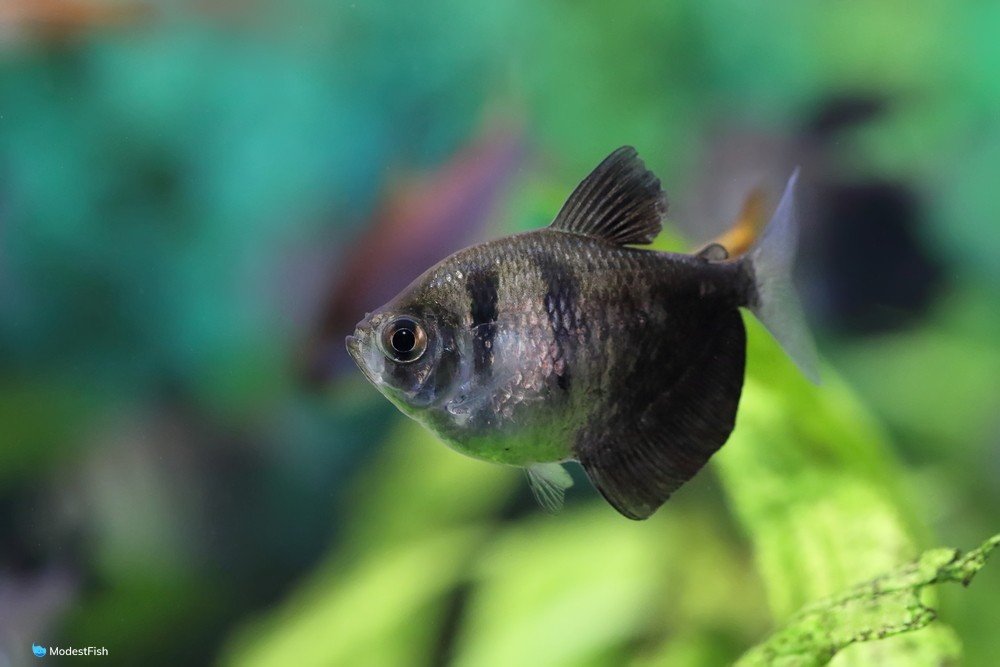
Black skirt tetras are a bit bigger than many of the other tetra species available at live fish stores. They are a very deep chested, plump fish with a silvery head and body.
They have two mottled vertical stripes that slash through the silver on their bodies and the entire back half of the fish is a deep matte black. They have overly large, trailing anal fins that hang down, forming their “black skirt.”
Black skirts are very peaceful and mostly just ignore other species of fish.
They’re by no means a directional schooler, but they almost always remain in their loose shoal, hardly ever wandering away from the group.
Sometimes, black skirts can be fin nippers, especially with other species with long, flowy fins. This usually decreases when they are kept in a large group because they pay more attention to each other instead of focusing on tank mates.
4. Congo Tetra (Phenacogrammus interruptus)
- Size: 3.5 inches (9 centimeters)
- Minimum tank size: 40 gallon (151 liter)
- Care level: medium
- Temperament: peaceful
- Schooling/shoaling fish: yes, should be kept in a group of 5 or more
- Temperature: 75°-82°F (24°-28°C)
- Diet: omnivore
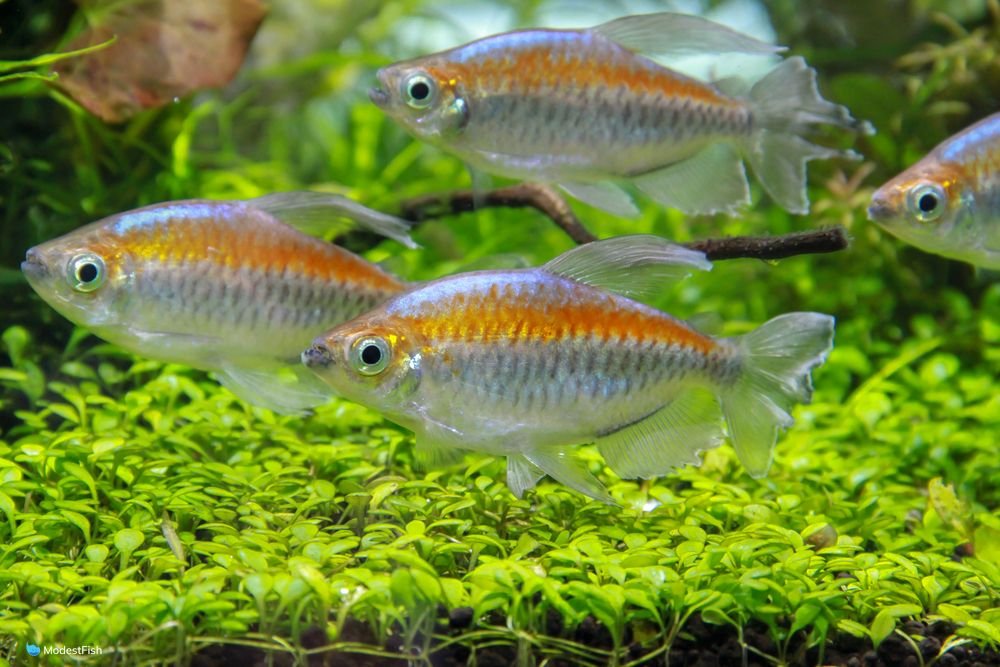
Congo tetras are a vibrant and active fish that make great centerpieces for larger aquariums. Not only do these fish get almost 4 inches long, they’re also extremely fast swimmers that like to zip around the tank.
They are prone to jumping, so it’s best to keep them in a tank with a lid.
Male congo tetras are much more colorful than the females. They have a bright iridescent sheen that covers the sides of their bodies.
Females are a little bit smaller than males and are a plain, drab brownish gray with shorter fins.
Many times, in live fish stores, they sell only male congos. But, an all male group can live peacefully with each other no problem, and they’re the flashy colorful ones anyway, so it’s no big loss.
These guys can be a bit pushy at feeding time. You’ll need to make sure that they are not outcompeting other fish for food.
But, if you do have the room for them, this species is a real show stopper.
5. Neon Tetra (Paracheirodon innesi)
- Size: 1.2 inches (3 centimeters)
- Minimum tank size: 10 gallon (39 liter)
- Care level: easy
- Temperament: peaceful
- Schooling/shoaling fish: yes, should be kept in a group of 5 or more
- Temperature: 72°-76°F (22.2°-24.4°C)
- Diet: omnivore
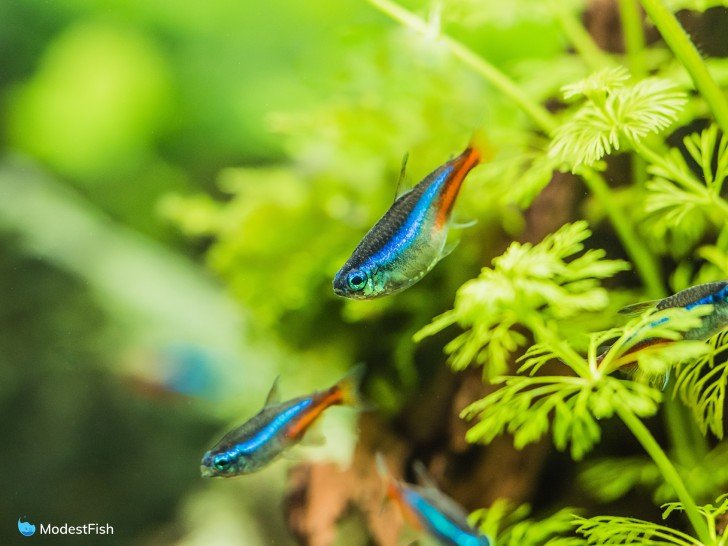
This species has been one of the mainstays of the aquarium hobby for decades.
Cute, colorful, active, hardy and long-lived, what’s not to like?
These little beauties have a bright blue stripe that reaches from their eyes to their dorsal fin and then a bright red stripe that runs from their dorsal fin to their tail.
The more neon tetras you have in a tank, and the bigger the tank is, the more interesting their shoaling behavior will be. Given enough room, they may even display directional schooling behavior.
These little guys can live up to 10 years with proper care. They like a combination of heavily planted areas, especially with tall plants, like jungle val, and open swimming areas.
6. Cardinal Tetra (Paracheirodon axelrodi)
- Size: 2 inches (5 centimeters)
- Minimum tank size: 20 gallon (76 liter)
- Care level: medium
- Temperament: peaceful
- Schooling/shoaling fish: yes, should be kept in a group of 5 or more
- Temperature: 73°-81°F (23°-27°C)
- Diet: omnivore
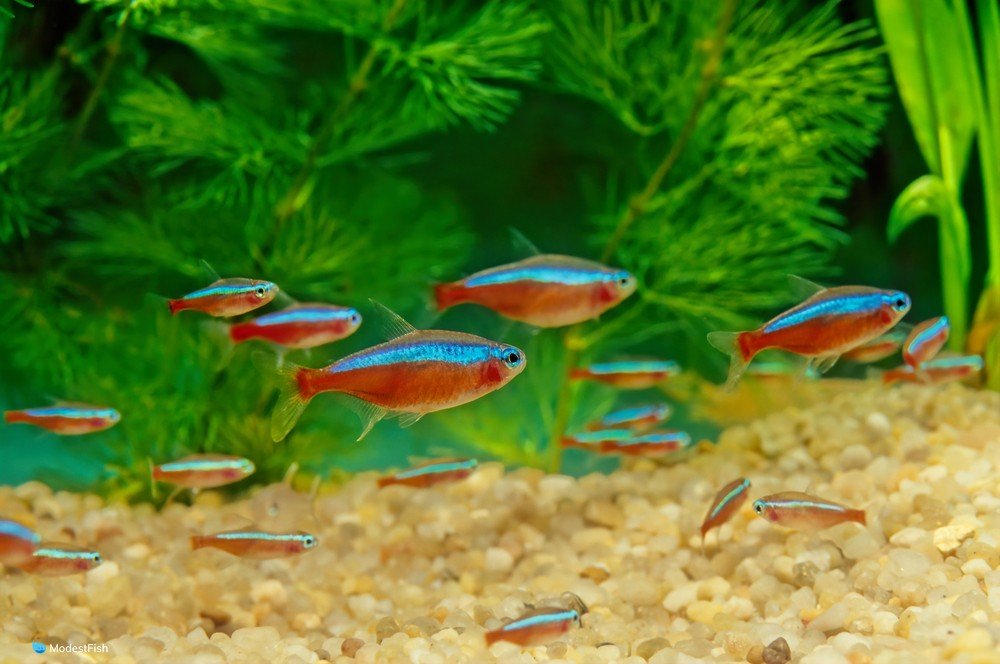
It’s really easy to mix up neon tetras and cardinal tetras. Both have bright, iridescent red and blue stripes, the same slim body shape and are very close in size.
The easiest way to tell them apart is their stripes. Both the blue and red stripes on a cardinal tetra run all the way from nose to tail.
On neon tetras, the blue stripe only runs from their nose to their dorsal fin, and the red stripe only goes from their dorsal fin to their tail.
Cardinals are a bit bigger than neons, but it’s hard to tell if the tanks aren’t right next to each other.
Caring for cardinals is much the same as neons. They’re fairly hardy, just make sure to keep up with your water changes.
7. Ember Tetra (Hyphessobrycon amandae)
- Size: 0.5-0.8 inches (1.25-2 centimeters)
- Minimum tank size: 10 gallon (39 liter)
- Care level: easy
- Temperament: peaceful
- Schooling/shoaling fish: yes, should be kept in a group of 5 or more
- Temperature: 73°-82°F (23°-28°C)
- Diet: omnivore
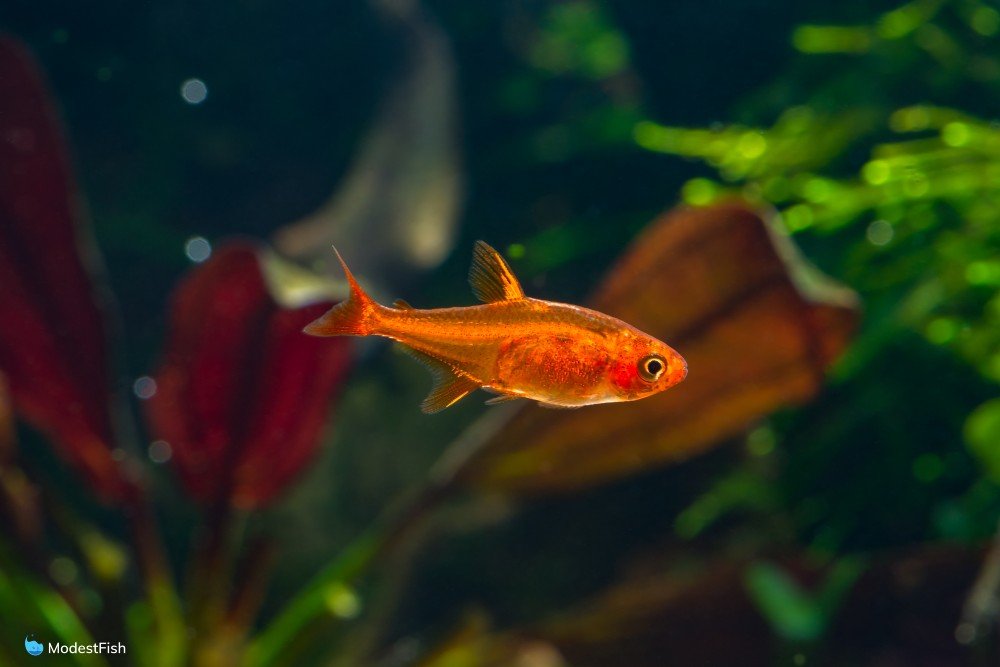
Ember tetras are a great way to add a pop of color to your tank. They range from a golden color to bright red.
Keeping them in a tank with a dark substrate will make their colors stand out even more.
This species is another peaceful schooling fish that needs to be kept in a group of five or more.
Males have a slimmer build and females have more of a round belly.
Make sure that you only mix them with other nano species to prevent these little guys from getting eaten. It’s best to keep them with other small fish, like chili or harlequin rasboras.
8. Glowlight Tetra (Hemigrammus erythrozonus)
- Size: 2 inches (5 centimeters)
- Minimum tank size: 20 gallon (76 liter)
- Care level: easy
- Temperament: peaceful
- Schooling/shoaling fish: yes
- Temperature: 74°-82°F (23°-28°C)
- Diet: omnivore
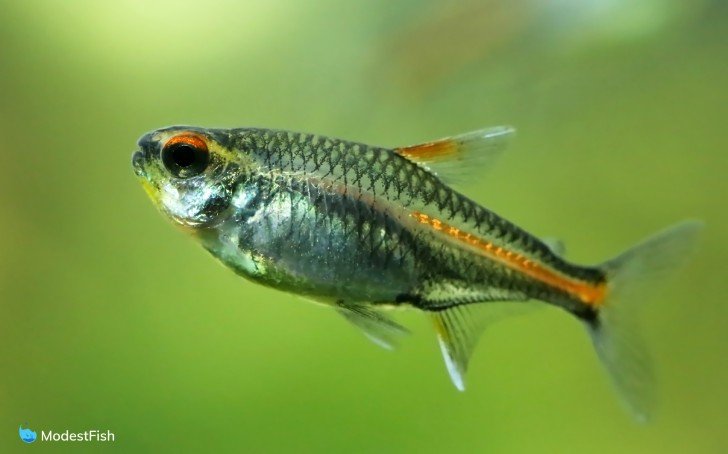
Glowlight tetras are a tiny silver fish that has a bright red-orange stripe that runs from nose to tail.
And don’t worry, this is their natural color, they haven’t been injected with dye or genetically modified.
Thankfully, the practice of injecting fish with dye has become much less prevalent due to overwhelming public outcry against the process.
This species is a shoaling fish that needs to be kept in the largest group possible. They find comfort in numbers, keep at least a school of five in order to make them feel happy and secure.
Glowlights are shy little fish that do best in a dimly lit, heavily planted tank. They like to dart in and out of tall plants as a group. They also appreciate floating plants, like Brazilian pennywort and frogbit.
9. Diamond Tetra (Moenkhausia pittieri)
- Size: 2.5 inches (6 centimeters)
- Minimum tank size: 40 gallon (151 liter)
- Care level: medium
- Temperament: peaceful
- Schooling/shoaling fish: yes, should be kept in a group of 5 or more
- Temperature: 72°-82°F (22°-28°C)
- Diet: omnivore
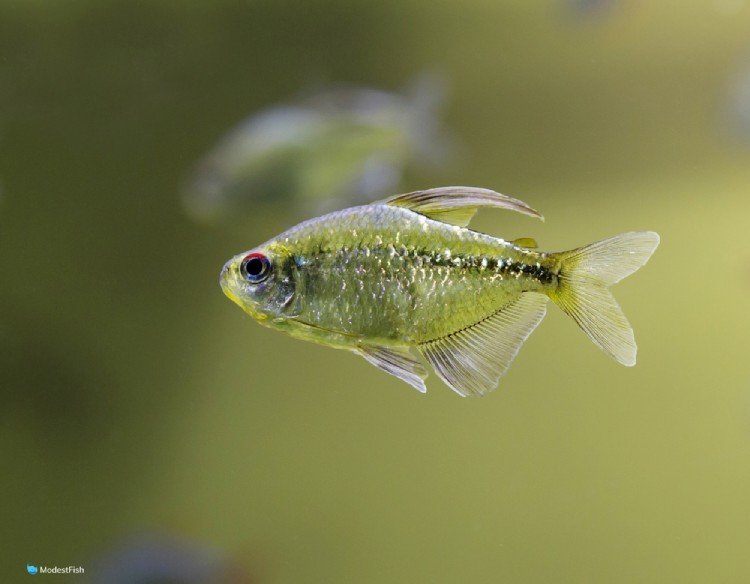
These fish are not a good choice for an open-topped tank. They can and will jump out of an aquarium; so, it’s best to put them in a tank with a tight fitting lid.
Diamond tetras are very close cousins to Congo tetras. Their bodies and fins are so similarly shaped, that it could be easy to confuse the two species.
But, diamond tetras have highly reflective, shimmery scales (especially males), rather than the rainbow effect of the Congo tetra. These brightly flashing scales, that shine like precious stones, are what give the diamond tetra its name.
Males are a bit flashier and have more flowy fins. But, the females are also quite pretty, just a little more subdued than the males.
This species is hardy and fairly low maintenance, but they can outcompete slower tank mates at feeding time.
Diamond tetras are another active schooling fish that does best in a larger tank. You could keep a single fish in a 15 gallon, but since you need to keep a school, you’re better off going with at least a 40 gallon tank.
10. Dwarf Pencilfish (Nannostomus marginatus)
- Size: 1 inch (2.5 centimeters)
- Minimum tank size: 10 gallon (39 liter)
- Care level: medium
- Temperament: peaceful
- Schooling/shoaling fish: yes, should be kept in a group of 5 or more
- Temperature: 75°-79°F (24°-26°C)
- Diet: carnivore
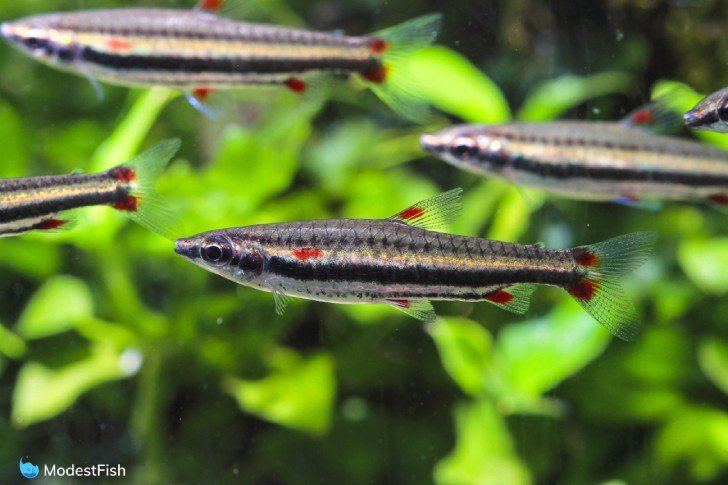
These guys are truly adorable. Dwarf pencilfish are only about an inch long with black horizontal stripes that run nose to tail along a lighter body. Some variants may have a solid stripe of red or even a yellowish body color.
This species comes from slow moving blackwater environments packed with vegetation. They prefer to hang out at the surface of the water, hiding among floating plants.
I ranked this species as medium difficulty level for two reasons.
First, you really do need to set up the tank a certain way in order to keep these fish happy. You need a densely planted tank that has lots of cover at the water’s surface.
Second, they should be fed mostly live and frozen foods, things like daphnia and baby brine shrimp. They may accept crushed flakes, but you’ll need to ensure it’s small enough to fit in their tiny, tiny mouths.
11. Celestial Pearl Danio (Danio margaritatus)
- Size: 1 inch (2.5 centimeters)
- Minimum tank size: 10 gallon (39 liter)
- Care level: medium
- Temperament: peaceful
- Schooling/shoaling fish: yes, should be kept in a group of 5 or more
- Temperature: 73°-79°F (23°-26°C)
- Diet: omnivore
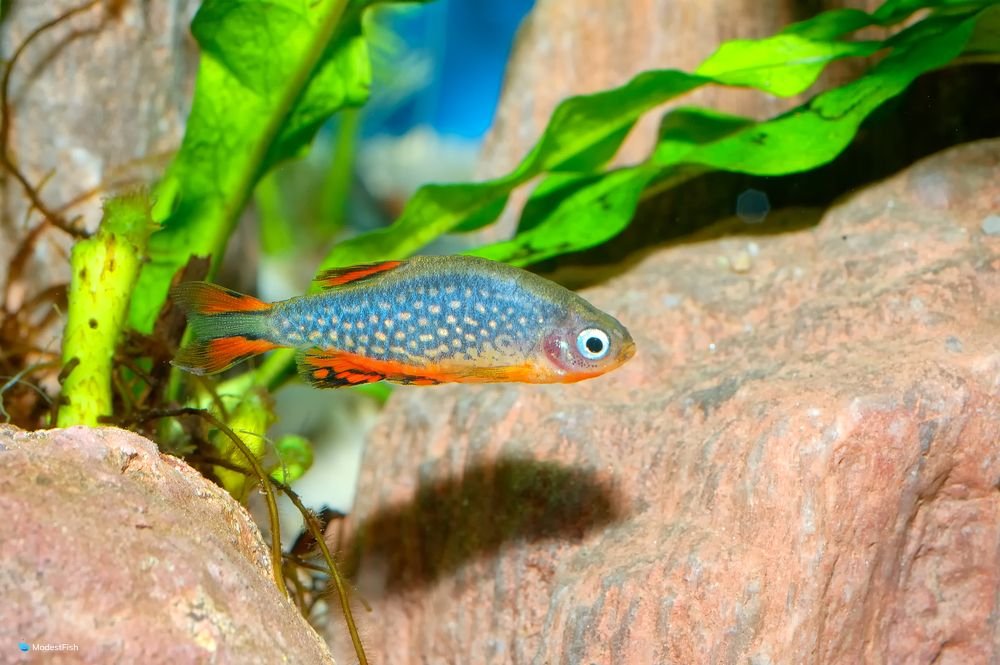
The celestial pearl danio is a bit of a newcomer to the aquarium hobby, but it has quickly taken the fish lovers by storm. Small, peaceful and colorful, these little fish are sure to draw the eye.
They have a blue/olive green body, dotted with yellow speckles, that’s bordered by a bright red tail and fins. They have large eyes and sport a bright orange belly.
This species likes to hang around the bottom of the tank, along the substrate. They like a very slow moving current in the aquarium, so sponge filters are a good choice to use with this fish.
Celestial pearl danios need lots of hiding spots to feel secure. They do best with a combination of densely planted areas and open swimming areas.
12. Cory Catfish (Corydoras sp.)
- Size: 1-4 inches (2.5-10 centimeters)
- Minimum tank size: 30 gallon (113 liter)
- Care level: medium
- Temperament: peaceful
- Schooling/shoaling fish: yes, should be kept in a group of 5 or more
- Temperature: 72°-82°F (22°-28°C)
- Diet: omnivore
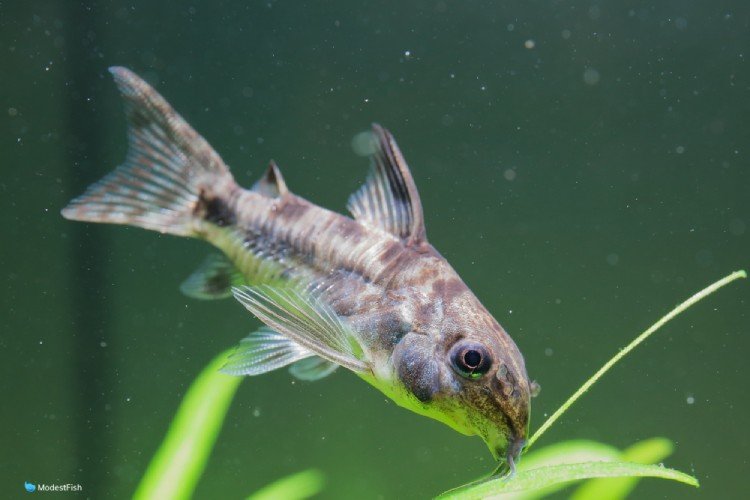
I tried not to just jumble big groups of fish together for this article. I didn’t want to just say something like, “peaceful tetras.” Instead, I wanted to list most species individually, so I could highlight some lesser known, but totally awesome, species of fish.
But, I’m going to have to make an exception when it comes to corydoras catfish. There are just so many species of corydoras that this article would be a hundred pages long if I tried to list them all out.
Luckily, they’re all fairly similar. They’re all cute little schooling catfish with flat bellies, domed heads, bodies that sharply taper down to their tails and barbels around their mouths.
They range in size from the tiny 1 inch panda cory to the much larger 4 inch banded cory. Each species has its own unique color and pattern. I particularly like Corydoras julii, with its intricate patterns of dots and lines.
Cories are great little cleaner fish that will scour the bottom of your tank for uneaten food. And the more of them you keep, the more bold and playful they will become, always goofing around with each other.
13. Pictus Catfish (Pimelodus pictus)
- Size: 6 inches (15 centimeters)
- Minimum tank size: 55 gallon (208 liter)
- Care level: medium
- Temperament: mostly peaceful, they may squabble among themselves
- Schooling/shoaling fish: yes, should be kept in a group of 5 or more
- Temperature: 74°-78°F (23°-26°C)
- Diet: omnivore
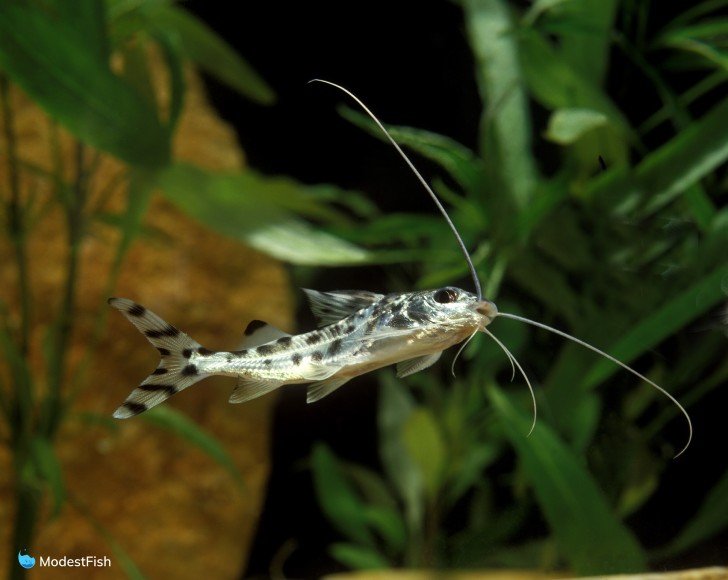
Pictus are striking catfish with bright, shimmery bodies and long whip-like whiskers.
This species can be shy at times and needs lots of caves they can retreat to when they feel spooked. It’s best to keep this species as a group, so you’ll need to make sure there are enough hiding places for all of them.
When they do emerge from their hiding spots, pictus are fast moving fish that can dart from place to place in the blink of an eye. They do best in a tank with a large footprint so they have plenty of space to move around.
Pictus catfish can grow to be 6 inches long, so they’ll need to be in at least a 55 gallon tank, but bigger is always better.
14. Upside-Down Catfish (Synodontis nigriventris)
- Size: 4 inches (10 centimeters)
- Minimum tank size: 40 gallon (151 liter)
- Care level: medium
- Temperament: peaceful
- Schooling/shoaling fish: yes, should be kept in a group of 5 or more
- Temperature: 72°-82°F (22°-28°C)
- Diet: omnivore
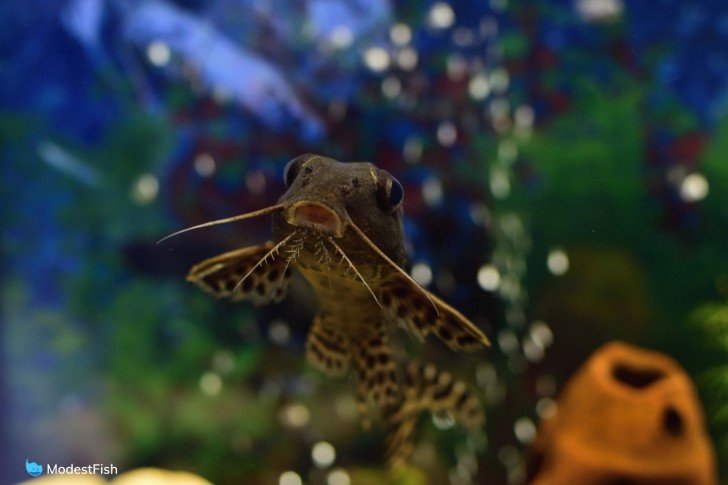
The upside-down catfish has got to be one of the goofiest things I’ve ever seen. These guys turn themselves upside-down so they can swim along the surface and eat food.
They don’t always swim upside-down, though. They will also turn themselves back over so that they can feed along the substrate at times.
Food at the surface, food along the bottom, they’ll take either one, they’re flexible.
This species is very social. They will want to have hiding spaces that can hold the whole school. Caves under rocks or driftwood are great for them.
Upside-down catfish are sensitive to nitrates, and as such, may not be the best choice for beginners. This species will need to be kept in a well established tank that gets regular water changes.
They also appreciate well oxygenated water and a strong current in the aquarium.
15. Glass Catfish (Kryptopterus vitreolus)
- Size: 2.5 inches (6 centimeters)
- Minimum tank size: 30 gallon (113 liter)
- Care level: hard
- Temperament: peaceful
- Schooling/shoaling fish: yes, should be kept in a group of 5 or more
- Temperature: 70°-79°F (21°-26°C)
- Diet: carnivore
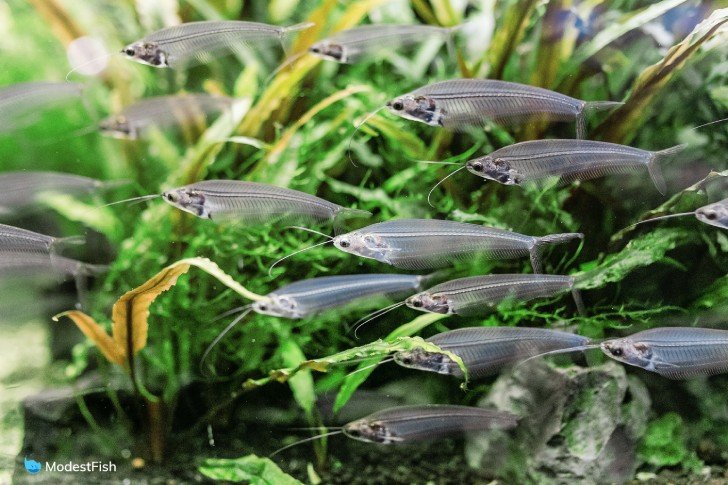
Glass catfish are really neat. I wish they weren’t so hard to come by.
Their bodies are almost entirely transparent, making it possible to see all of their organs and bones. You can easily overlook a whole school of them right in front of you when they tuck themselves in among tall plants.
This species is pretty delicate. So, I don’t recommend them for beginners. They need an established aquarium and very clean water.
Glass catfish are also quite shy and will do best in a heavily planted tank that has tall plants that reach the surface.
16. Cuckoo Catfish (Synodontis multipunctatus)
- Size: 6 inches (15 centimeters)
- Minimum tank size: 55 gallon (208 liter)
- Care level: medium
- Temperament: peaceful, but may squabble amongst themselves over hiding places
- Schooling/shoaling fish: yes, should be kept in a group of 5 or more
- Temperature: 75°-82°F (24°-28°C)
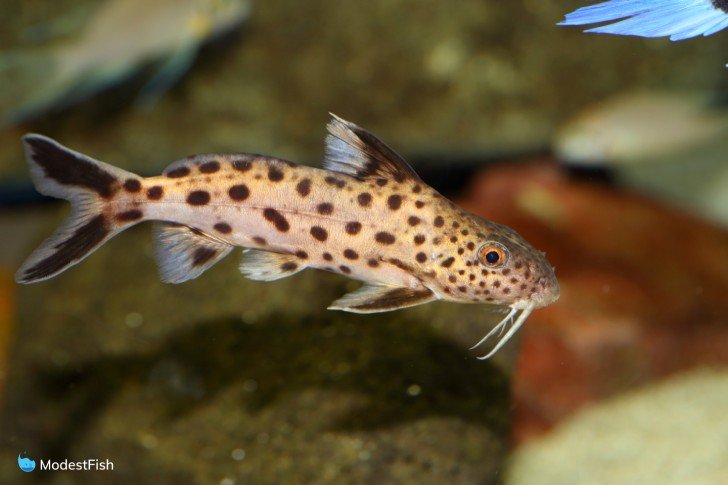
If you’ve got a bigger tank and want a knockout bottomfeeder, look no further. I love this species, I’ve kept them for years.
Cuckoo catfish are very eye-catching. They have dusky golden bodies covered in dark brown polka dots. As well, they have a beard of forked barbels that they use to find food along the substrate.
They can be very shy, especially when the lights are on. Make sure they have lots of caves to hide in during the day.
They will sometimes swim upside-down so they can feed along the surface (they’re close relatives of the upside-down catfish), but they mostly stay right side up.
17. Fancy Guppy (Poecilia reticulata)
- Size: 1-1.5 inches (2.5-3.5 centimeters)
- Minimum tank size: 5 gallon (19 liter)
- Care level: easy
- Temperament: peaceful
- Schooling/shoaling fish: yes. I recommend keeping a male only group to avoid fry. For a mixed group, you’ll need 3 females for every 1 male.
- Temperature: 72°-84°F (22°-29°C)
- Diet: omnivore
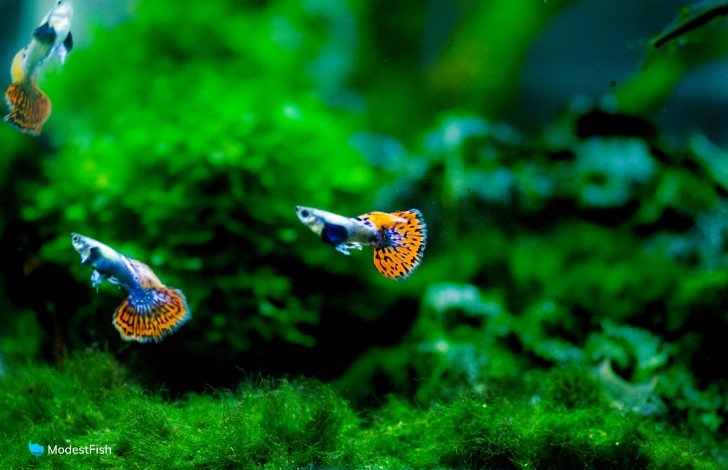
Fancy guppies are one of the mainstays of the aquarium trade. These colorful, active, goofball fish are hardy and just plain fun to watch.
Some might look down on them for being “common” fish, but I think they’re common because they’re awesome!
I highly recommend keeping a male only group because these little guys are prolific breeders.
Males are colorful, but females are very drab. So, you actually have a more colorful tank by limiting yourself to only males.
But, if you are absolutely set on having a mixed tank, you should keep a ratio of one male to three females.
Guppies are livebearers, meaning they give birth to live young instead of laying eggs. They will readily breed in an aquarium, but adults will often eat the babies.
Fancy guppies come in a wide array of colors and tail shapes, and so, can add a lot of color and variety to your tank.
18. Endler’s Livebearer (Poecilia wingei)
- Size: 1 inch (2.5 centimeters)
- Minimum tank size: 5 gallon (19 liter)
- Care level: easy
- Temperament: peaceful
- Schooling/shoaling fish: yes. Male only group is best to avoid unwanted fry. For mixed tanks, you’ll need 3 females per male.
- Temperature: 65°-82°F (18°-28°C)
- Diet: omnivore
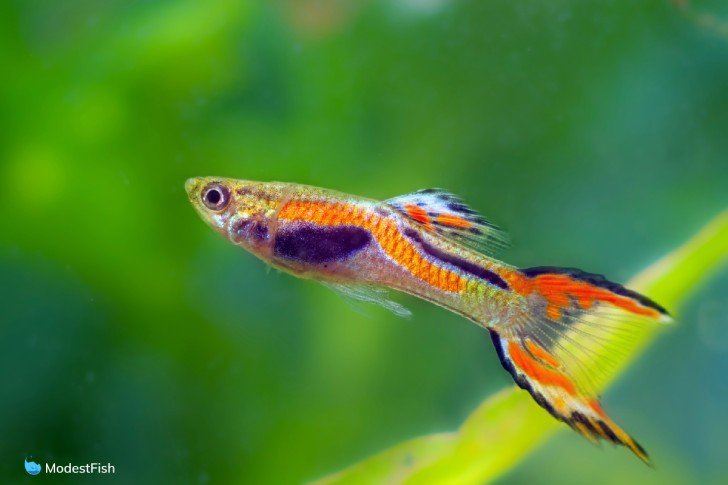
In my opinion, Endlers are amazing little fish. They are so brightly colored that they almost look supernatural.
There are several different color variations and they all look like a neon Technicolor dream.
These guys make great dither fish, small fish that you place in the tank to make shy fish feel more comfortable. The bigger fish assume that all is well as long as the dither fish are out and swimming around, signally that they are safe to emerge from hiding.
Just make sure that tank mates aren’t big enough to swallow the Endlers.
These fish are quite hardy, much like their close cousin, the guppy. I have found them to be easy keepers. You just have to ensure that you provide food that is small enough to fit in their tiny mouths.
I feed mine crushed flake food, which they readily accept.
19. Platy (Xiphophorus sp.)
- Size: 3 inches (7.5 centimeters)
- Minimum tank size: 20 gallon (76 liter)
- Care level: easy
- Temperament: peaceful, don’t mix with guppies
- Schooling/shoaling fish: yes, should be kept in a group of 5 or more
- Temperature: 70°-80°F (21°-27°C)
- Diet: omnivore
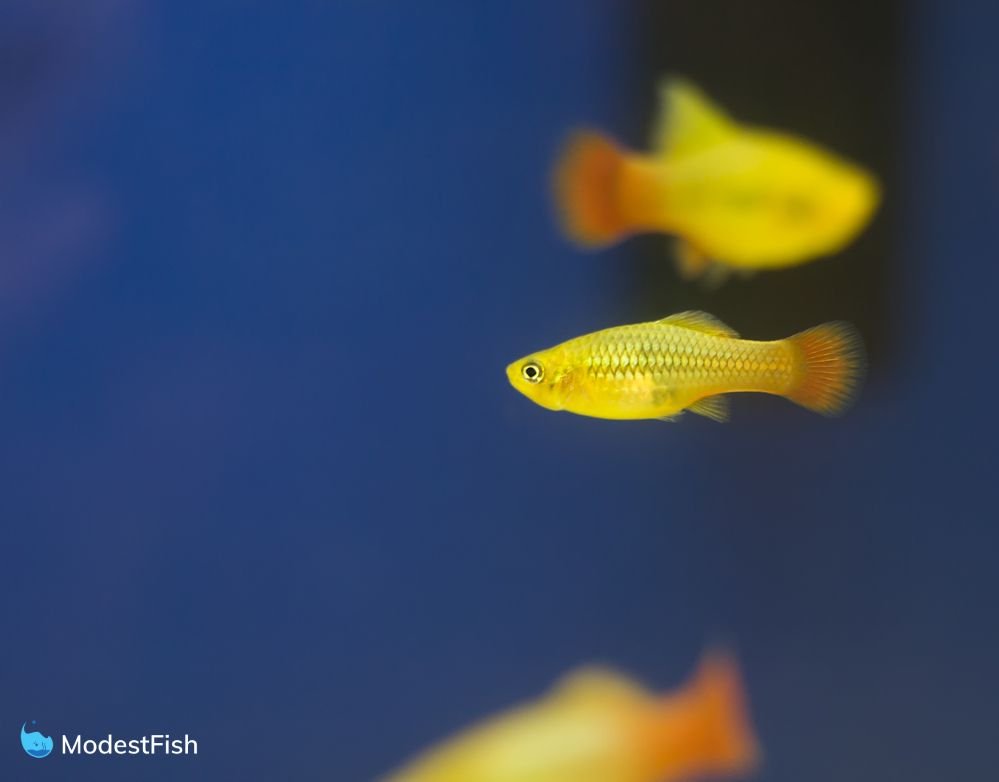
Platies are pretty darn adorable. They’re brightly colored and constantly in motion. They’ll also eat just about anything that’s not nailed down.
They come in a wide variety of colors and patterns. The Mickey Mouse ones are super cute, but I think my favorite would have to be the wagtail; I love the contrast between their brightly colored bodies and their black fins and tails.
These little guys are really easy to take care of and are very hardy.
You can mix platies with most other appropriately sized peaceful fish, but I do not recommend that you mix them with guppies!!
Male platies will constantly harass female guppies, trying to mate with them. And male guppies will constantly harass female platies, trying to mate with them. It just doesn’t go well in my experience.
Platies are sold as a mix of male and female. It’s actually kind of tricky to tell the sexes apart. Males are a bit leaner and females a bit more rounded, but these traits usually aren’t very prominent when they’re still juveniles.
Since they’re mostly sold as juveniles, you’re most likely to get a mix of male and female fish and they will produce a bunch of babies.
The adults will usually devour the babies, but if they have enough cover in the tank, some will survive. You may need an outlet to find them new homes.
20. Molly (Poecilia sp.)
- Size: 4-6 inches (10-15 centimeters)
- Minimum tank size: 30 gallon (113 liter)
- Care level: medium
- Temperament: peaceful
- Schooling/shoaling fish: yes, should be kept in a group of 5 or more
- Temperature: 75°-80°F (24°-26.7°C)
- Diet: omnivore
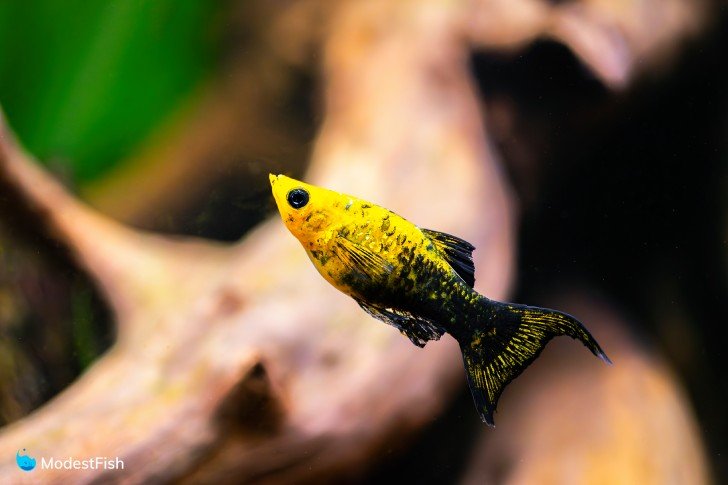
Mollies are another livebearer, like platies and guppies. I think they’re really interesting because they are the only fish on this list that is capable of living in both fresh, brackish and saltwater.
In fact, many overseas breeders raise their mollies in saltwater since freshwater out of the tap costs money, but saltwater from the ocean or an estuary is free.
There are several different species sold under the common name molly. Shortfin mollies tend to top out around 4 inches, but sailfin mollies can reach 6 inches in length. There are many, many different color and fin variations that have been selectively bred, they’re quite beautiful.
One thing I’ve always liked about mollies: they love to pick at algae, especially hair algae. I’m not saying that they will keep a tank completely algae free, but their constant pecking can help keep it in check.
Please, avoid buying balloon mollies. These fish have been bred to have a spinal deformity that curves their backs and makes their bellies jut out. This deformity of the spine causes constant pressure on their internal organs and balloon mollies tend to have a shorter lifespan than regular mollies.
21. Hatchetfish (Carnegiella strigata)
- Size: 1 inches (2.5 centimeters)
- Minimum tank size: 30 gallon (113 liter)
- Care level: medium
- Temperament: peaceful
- Schooling/shoaling fish: yes, should be kept in a group of 5 or more
- Temperature: 78°-82°F (26°-28°C)
- Diet: carnivore
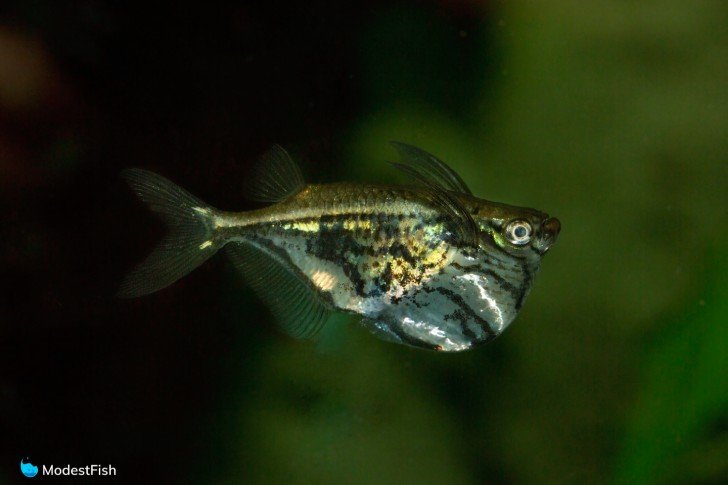
There are a lot of silver fish in the aquarium trade. Even so, hatchetfish have always stood out to me because they are so bright and reflective. I love the way they flash bright silver as they swim around.
Hatchetfish have a very strange body shape. Their heads and backs look like any other small schooling fish, but their chests curve drastically, giving them a mutton chop kind of shape.
This unusual trait has a purpose. These guys are world class jumpers, to the point that they are considered a “flying fish.” Their unusual body shape is due to huge (relative to their size) muscles that control their pectoral fins.
When startled by a predator, hatchetfish can beat their fins rapidly and scoot along the surface of the water, or even leave the water completely.
They need to be kept in a tank with a very tight lid; they are notorious for jumping out of aquariums. Hatchetfish will even aim for small cracks or gaps in the lid, trying to jump through them.
22. Zebra Loach (Botia striata)
- Size: 4 inches (10 centimeters)
- Minimum tank size: 40 gallon (151 liter)
- Care level: easy
- Temperament: peaceful but will have minor squabbles amongst themselves
- Schooling/shoaling fish: yes, should be kept in a group of 5 or more
- Temperature: 75°-80°F (24°-27°C)
- Diet: omnivore
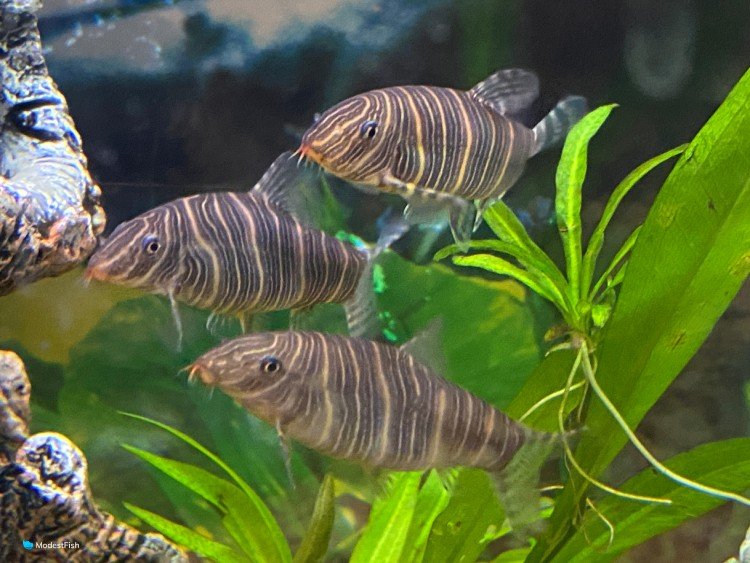
I’m pretty passionate about this species. I’ve got a school of them in my rainbowfish tank that I’ve had for about 5 years now, great little fish.
Many people become enamored with the zebra loach’s larger cousin, the clown loach (Chromobotia macracanthus), because of their bright orange color and brown stripes.
Unfortunately, what most people don’t realize is that a clown loach can easily grow to be a foot long and they require at least a 100 gallon (379 liter) aquarium when they’re full grown.
But, zebra loaches top out at 4 inches long and can be kept in a 40 gallon.
I love watching my school roam around the tank. They are total goofballs. They all stuff themselves into one tiny hiding spot so they can sleep together in a big pile.
They are great cleaner fish that keep the substrate free of uneaten food. They are also EXCELLENT snail eaters. They will gang up and eat even the biggest of snails.
So, if you’re looking for a fish to eat up bladder snails, look no further than the zebra loach.
23. Kuhli Loach (Pangio kuhlii)
- Size: 4 inches (10 centimeters)
- Minimum tank size: 20 gallon (76 liter)
- Care level: easy
- Temperament: peaceful and very shy
- Schooling/shoaling fish: yes, should be kept in a group of 5 or more
- Temperature: 75°-85°F (24°-29°C)
- Diet: omnivore
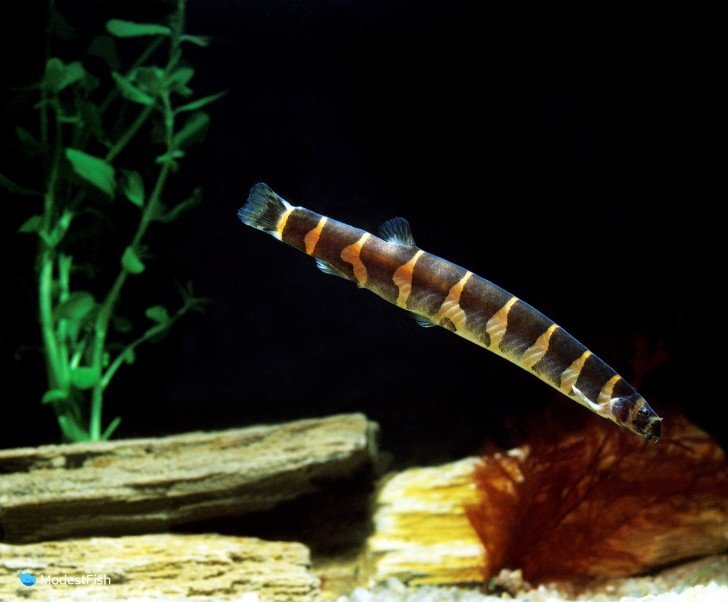
This adorable little oddball is another great little cleaner fish.
Kuhli loaches are very shy little critters that don’t ever bother anybody. They just want to munch on everybody’s leftovers.
At first glance, you might think that a Kuhli loach is a small eel, but technically, it is a fish. Eels don’t have dorsal fins and their caudal and anal fins are fused together.
Kuhli loaches have separate anal and caudal fins and they also have a dorsal fin. So, they’re a fish, not an eel.
These little guys will spend the majority of their daylight hours hiding. After the lights go out, they’ll emerge and eat up anything they can find along the substrate.
Kuhli loaches like to pile into a little hiding spot in a big group. It’s important to give them lots of hiding spaces. Small caves or gaps underneath rocks, driftwood and other decor will do nicely.
24. Otocinclus Catfish (Otocinclus vestitus)
- Size: 1.5-2 inches (4-5 centimeters)
- Minimum tank size: 20 gallon (76 liter)
- Care level: medium
- Temperament: peaceful
- Schooling/shoaling fish: yes, should be kept in a group of 5 or more
- Temperature: 72°-82°F (22°-28°C)
- Diet: herbivore
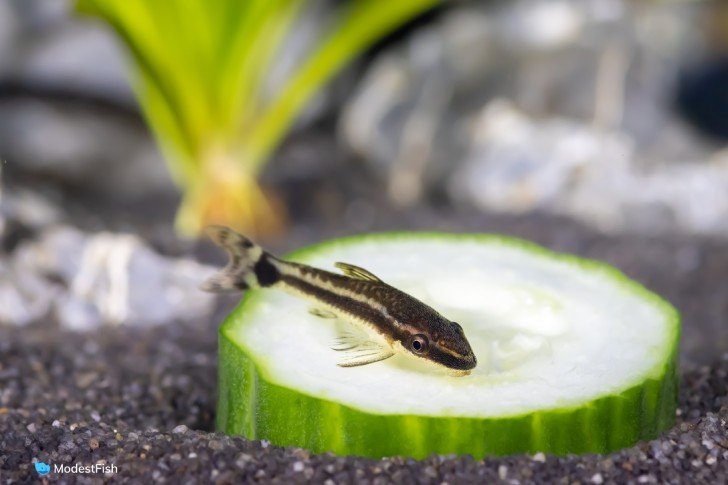
This is my number one recommended algae-eating fish. These little dudes will scour your tank for soft algaes and uneaten food, they’re amazing.
They’re also super adorable! They almost always stick together as a group. Otos will play with each other like a bunch of rowdy little kids, so fun to watch.
They need to be kept in a group to feel secure. The more, the merrier.
Oto cats have sucker mouths, similar to a pleco. But, unlike a lot of plecos, they stay very small.
They do struggle to eat some of the tougher algaes, like black beard. If you can, combine these guys with Amano shrimp for a nearly algae free aquarium. Amanos can eat black beard algae, so mixing them with oto cats will help scrub your tank clean.
Oto cats really need clean water. Do not put them in a newly set up tank. They cannot handle ammonia spikes or fluctuating water parameters. Also, there needs to be a good, steady supply of algae for them to eat, or they might starve to death.
I highly recommend this species. You gotta love an adorable little fish that’s also a powerful addition to your tank cleanup crew.
25. Clown Pleco (Panaqolus sp.)
- Size: 3.5-4 inches (9-10 centimeters)
- Minimum tank size: 30 gallon (113 liter)
- Care level: easy
- Temperament: peaceful
- Schooling/shoaling fish: no. This fish prefers to live alone.
- Temperature: 75°-82°F (24°-28°C)
- Diet: herbivore
You have to be careful when you’re buying plecos. What looks like a cute little fish in the pet store can grow to be an enormous tank buster in less than a year.
But, clown plecos top out around 4 inches, much more practical for the average hobbyist.
They have a really pretty mottled pattern that acts as great camouflage in their natural environment.
They’re a fairly good algae eater, but they can get a little lazy about it if there’s leftover fish food to eat.
Clown plecos can be very shy. So, it’s best to provide them with several hiding places that they can retreat to during the day. They also really benefit from having driftwood in the tank. They’ll munch on it throughout the day and get some extra fiber.
26. Bristlenose Pleco (Ancistrus sp.)
- Size: 3-5 inches (7.5-13 centimeters)
- Minimum tank size: 30 gallon (113 liter)
- Care level: easy
- Temperament: very territorial with other plecos, super peaceful with other fish
- Schooling/shoaling fish: no, prefers to be kept alone
- Temperature: 75°-80°F (24°-27°C)
- Diet: herbivore
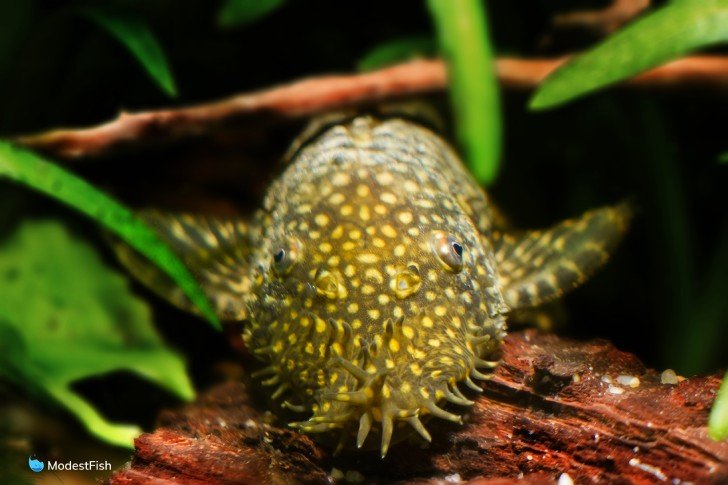
Bristlenose plecos are great algae eaters that fit well into most community tanks. They’re a bit too big to mix with tiny nano fish, like chili rasboras. Even plecos have been known to gulp up itty, bitty fish that easily fit in their mouths.
Males display a patch of fleshy tentacles that grow from their noses. There is currently not a scientific consensus on the purpose of this unique feature. However, it’s been theorized that it helps the fish sense water currents, or perhaps it helps males rear their young.
Either way, these fish are so ugly that they’re cute. They are great at eating soft algae species and will also gladly gobble up leftover fish food.
Plecos can be very territorial with other plecos, so it’s usually best to keep only one per tank. Bristlenose will basically ignore non-pleco fish species.
27. Dwarf Neon Rainbowfish (Melanotaenia praecox)
- Size: 3 inches (7.5 centimeters)
- Minimum tank size: 30 gallon (113 liter)
- Care level: easy
- Temperament: peaceful
- Schooling/shoaling fish: yes, should be kept in a group of 5 or more
- Temperature: 75°-80°F (24°-27°C)
- Diet: omnivore

I really don’t know why more people don’t keep this species in their community tanks.
I’m a huge fan of rainbowfish. There are several different species available in the aquarium trade. They’re active, colorful and really peaceful.
The dwarf rainbow fish (aka dwarf neon, Praecox rainbowfish) only reaches a length of 3 inches. They have silver bodies that are covered in a bright blue iridescent sheen and bright red fins.
It never fails that guests comment on them; they are so eye-catching.
These fish are fairly energetic and prefer to stay in open swimming areas in the mid/top region of the tank.
28. Boesemani Rainbowfish (Melanotaenia boesemani)
- Size: 4 inches (10 centimeters)
- Minimum tank size: 40 gallon (151 liter)
- Care level: easy
- Temperament: peaceful
- Schooling/shoaling fish: yes, should be kept in a group of 5 or more
- Temperature: 75°-80°F (24°-27°C)
- Diet: omnivore
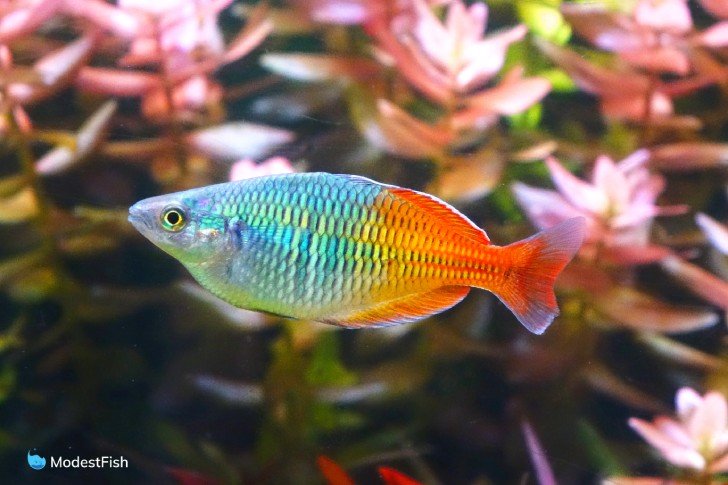
The Boesemani rainbowfish has to be one of my all time favorites. I’ve kept this species for well over a decade.
They are a very striking fish. The front half of their bodies is bright blue and the back half is bright yellow.
This species is very active. They spend the majority of the day swimming up and down the length of the tank. They do best in a tank with a long footprint. This gives them a longer run down the tank before they have to turn back around.
Boesemani rainbowfish may squabble a little amongst themselves, but they will studiously ignore other species of fish.
29. Australian Rainbowfish (Melanotaenia fluviatilis)
- Size: 4 inches (10 centimeters)
- Minimum tank size: 40 gallon (151 liter)
- Care level: easy
- Temperament: peaceful
- Schooling/shoaling fish: yes, should be kept in a group of 5 or more
- Temperature: 72°-77°F (22°-25°C)
- Diet: omnivore
Australian rainbowfish are similar in size to Boesemani. They have a deep chest that tapers to their strong forked tails. Their bodies are silver and covered with an iridescent blue-green sheen.
Like other rainbowfish, they are very active swimmers that prefer to zip up and down the length of the aquarium.
This species prefers large open swimming areas. They’ll dip into caves and in between plants sometimes, but they’d much rather spend their time in the open water.
These fish can live for over 5 years and are hardy, easy keepers that will eat anything that’s not nailed down.
30. Zebra Danios (Danio rerio)
- Size: 2 inches (5 centimeters)
- Minimum tank size: 10 gallon (39 liter)
- Care level: easy
- Temperament: mostly peaceful, but can be fin nippers
- Schooling/shoaling fish: yes, should be kept in a group of 5 or more
- Temperature: 65°-75°F (18°-24°C)
- Diet: omnivore
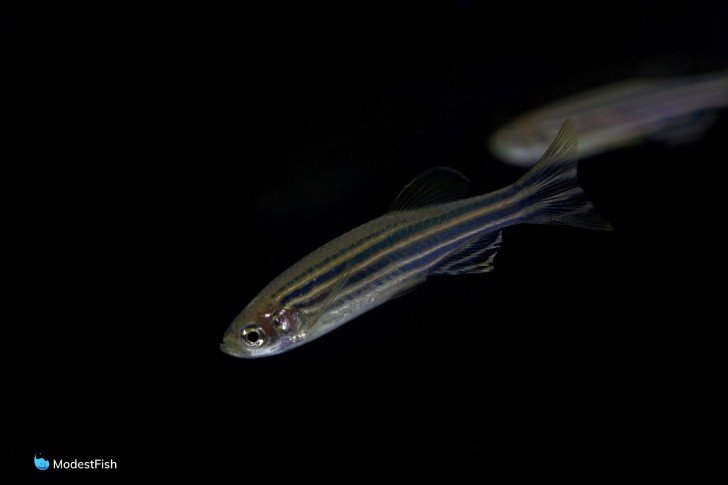
Zebra danios are a great species for beginners. These little guys are extremely hardy and aren’t too fussy about tank conditions.
They are often used in scientific genetic research because they are easy to keep and breed readily in an aquarium environment.
This species has beautiful gold and blue iridescent stripes that run from nose to tail.
Zebra danios are hyperactive little things, always zipping around and looking for something to get into. They especially enjoy areas of strong current in the tank; they’ll constantly swim against it like the fish version of a treadmill.
31. White Cloud Mountain Minnows (Tanichthys albonubes)
- Size: 1.5 inches (4 centimeters)
- Minimum tank size: 10 gallon (39 liter)
- Care level: easy
- Temperament: peaceful
- Schooling/shoaling fish: yes, should be kept in a group of 5 or more
- Temperature: 60°-75°F (16°-24°C)
- Diet: omnivore
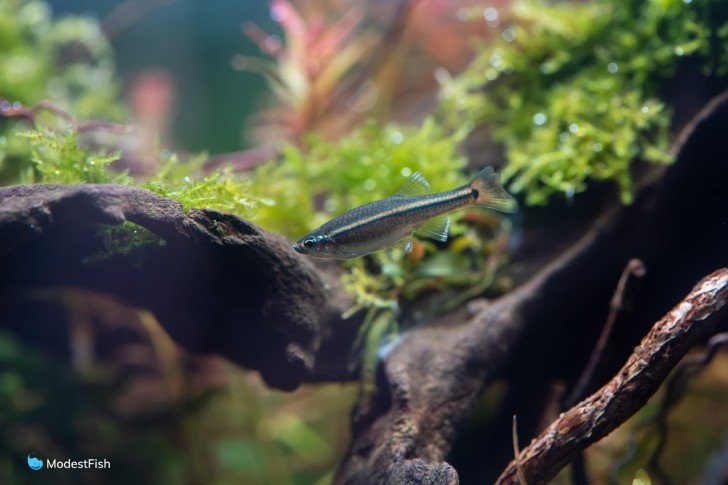
White cloud mountain minnows are a versatile species known to be very tolerant and hardy. They’re great for beginners.
These hyperactive little fish are native to the cold mountain streams of Baiyun Mountain in southern China.
They can tolerate both temperate and tropical temperatures. This makes them a great choice for unheated water gardens or cold water tanks.
At first glance, they may seem kind of plain, but once they’re settled into an environment, they develop bright stripes of iridescent color that run nose to tail. They also have bright red patches at the base of their tails, and on their dorsal fins, that are really pretty.
A long fin variety has been bred that is particularly nice looking.
32. Cherry Barb (Puntius titteya)
- Size: 2 inches (5 centimeters)
- Minimum tank size: 30 gallon (113 liter)
- Care level: easy
- Temperament: peaceful
- Schooling/shoaling fish:
- Temperature: 73°-81°F (23°-27°C)
- Diet: omnivore
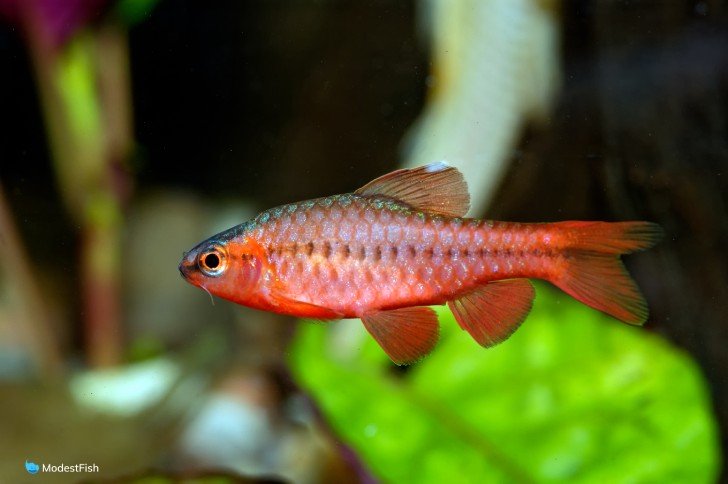
Cherry barbs are super cute little schooling fish. During the spawning season, the males turn a gorgeous bright red color.
Females have a whitish belly with a dark line that runs nose to tail. They have orange-gold bodies and bright red markings on their tail and fins. They’re not as showy as the males during breeding season, but they’re still a very pretty little fish.
One thing that I like about this species, you can mix them with small, super peaceful fish, like cory cats or neon tetras. Or they can even hold their own with some of the more aggressive schooling fish, like rosy and tiger barbs.
Cherry barbs are quite social, always staying together, but aren’t really a directional schooler.
It’s best to keep a mix of three or four females to every one male.
33. Honey Gourami (Trichogaster chuna)
- Size: 3 inches (7.5 centimeters)
- Minimum tank size: 5 gallons
- Care level: medium
- Temperament: peaceful and shy
- Schooling/shoaling fish: No. In a 20 gallon (76 liter) or larger, you can keep multiple honey gouramis as long as the tank is heavily planted.
- Temperature: 75°-82°F (24°-28°C)
- Diet: omnivore
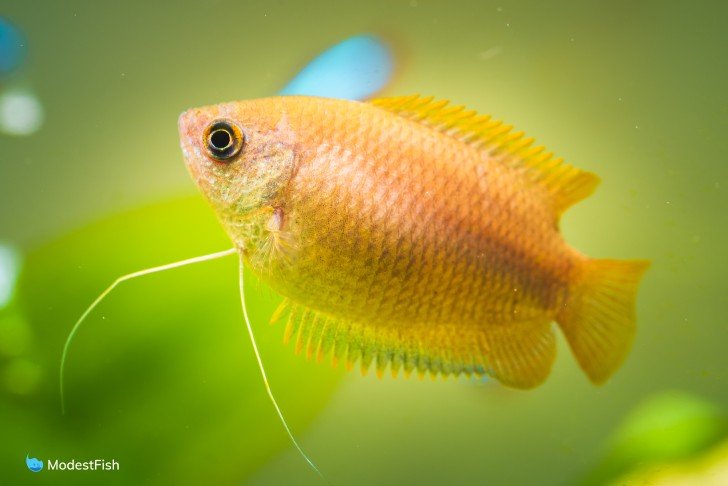
Honey gouramis are one of the most shy and peaceful of all the gourami species available in the pet trade.
This species is a Southeast Asian fish that inhabits vernal pools and can tolerate less than ideal water conditions and still thrive. They are quite hardy and a great fish for beginners.
Males are a bit more colorful than females. Their tails are a beautiful deep orange color that fades to a lighter orange towards their heads.
Like other gourami species, honey gouramis have modified, whisker-like pectoral fins that they use as touch organs to explore the world around them.
They are a labyrinth fish, meaning they have a crude lung-like organ that can extract oxygen from gulps of air the fish capture from the water’s surface.
It’s best to make sure you leave a gap between the top of the water and the tank’s lid to make sure your gourami can get some air.
Honey gouramis are mostly solitary creatures. You can keep more than one in a larger tank, such as a 30 gallon, as long as the tank is heavily planted so each fish can stake out a little separate territory.
34. Sparkling Gourami (Trichopsis pumila)
- Size: 1.5 inches (4 centimeters)
- Minimum tank size: 10 gallon (39 liter)
- Care level: easy
- Temperament: shy and peaceful
- Schooling/shoaling fish: no, but you can keep them as a large group.
- Temperature: 76°-82°F (24°-28°C)
- Diet: carnivore
This tiny species, also known as the pygmy gourami, is a very peaceful labyrinth fish.
Their sides and eyes have a bright iridescent flash that is quite pretty. Their body shape and fins are very similar to juvenile and female Bettas.
They will do best in a heavily planted tank with lots of tall and/or floating plants and they prefer dimmer lighting.
Sparkling gouramis are shy and retiring, so don’t mix them with fast moving, boisterous fish.
These fish are adept jumpers. Definitely keep them in a tank with a tight lid.
35. Pearl Gourami (Trichopodus leerii)
- Size: 4.5 inches (11.5 centimeters)
- Minimum tank size: 30 gallon (113 liter)
- Care level: medium
- Temperament: peaceful, but males can be territorial with same or similar species
- Schooling/shoaling fish: no, but this species can be kept in groups.
- Temperature: 77°-82°F (25°-28°C)
- Diet: carnivore
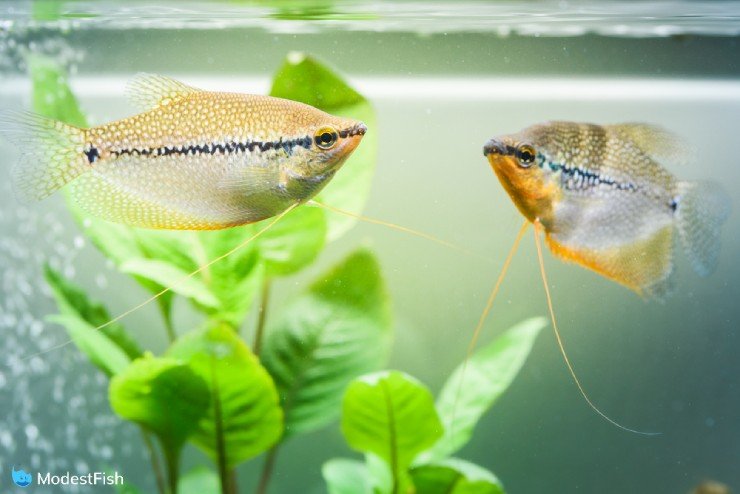
And, for the last fish on our list, I’ve got a real gem, the pearl gourami.
These fish are stunning. Their bodies are a light rosy pink and males have a bright red throat. They have a line of dark speckles that runs from nose to tail and through their eyes.
Most of their bodies and long, flowy fins are covered in an intricate pattern of pearly speckles, making them look almost like they’re covered in lace. Just beautiful.
They have the same modified pectoral fins as other gouramis.
This species is the most placid gourami species that you can find. They’re just big softies, which is awesome. You can keep them in large groups, unlike the other large gouramis species, they’re a great fish for a community tank.
36. Amano Shrimp (Caridina multidentata)
- Size: 1-3 inches (2.5-7.5 centimeters)
- Minimum tank size: 10 gallon (39 liter)
- Care level: easy
- Temperament: peaceful
- Kept in groups?: yes, and Amano shrimp will not reproduce in a freshwater tank.
- Temperature: 65°-80°F (18°-27°C)
- Diet: omnivore
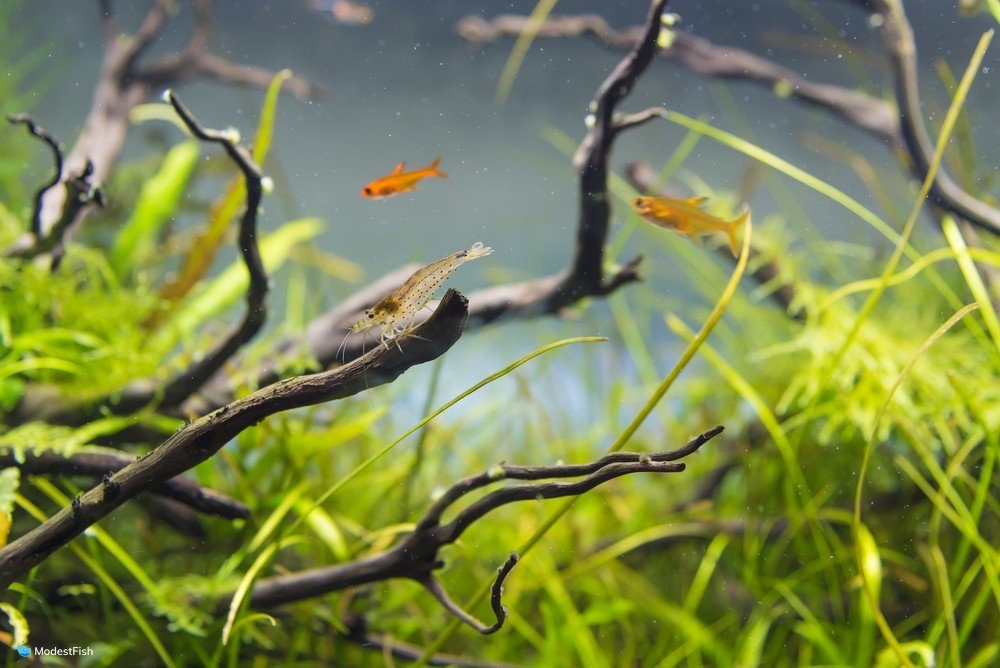
Hands down, this is the best algae eating species you can find in the aquarium hobby. These guys are AMAZING when it comes to tank cleanup crews.
They will eat even the toughest algae, like green spot and black beard.
Amanos can adapt to a wide variety of tank parameters, but will do best if they are kept in water with a high mineral content. They need calcium to help grow their shells.
37. Cherry Shrimp (Neocaridina davidi)
- Size: 1-1.25 inches (2.5-3 centimeters)
- Minimum tank size: 1 gallon (4 liter)
- Care level: easy
- Temperament: peaceful
- Kept in groups?: yes
- Temperature: 65°-80°F (18°-27°C)
- Diet: omnivore
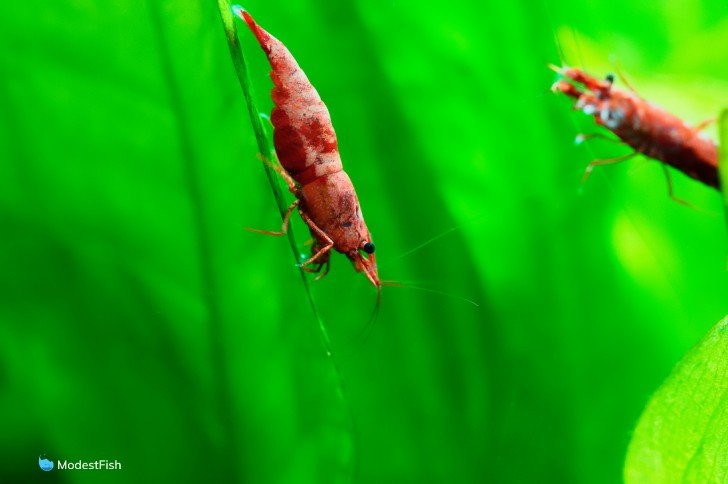
Cherry shrimp are probably the easiest ornamental shrimp to keep. They can adapt to a wide variety of tank conditions.
I’ve kept them in heated tanks, unheated tanks, soft water, hard water and everywhere in between; they just adapt and breed every time.
Cherries are great algae eaters but will struggle with the really tough species, like black beard. But, mix them with Amano shrimp, and your tank will be mostly algae free.
These guys are especially great for small low tech tanks. They will eat up algae while only adding a tiny bioload to the system.
38. Ghost Shrimp (Palaemonetes paludosus)
- Size: 1.5 inches (4 centimeters)
- Minimum tank size: 10 gallon (39 liter)
- Care level: easy
- Temperament: peaceful
- Kept in groups?: yes, and this species is unlikely to successfully breed in an aquarium.
- Temperature: 65°-80°F (18°-27°C)
- Diet: omnivore
Ghost shrimp (aka glass shrimp, grass shrimp) are really neat. They are almost completely transparent. This is a stellar form of camouflage. It can be really difficult to find them, even when you know they’re there!
Amano and cherry shrimp will feed along plant stems and leaves at all levels of the tank. But ghost shrimp tend to stay along the substrate. So, they’re not the best algae eaters.
However, they are a great choice if you just want a detritivore that will eat up food your fish leave behind.
Buy more than you ultimately want, since you’ll likely have some early die off, but the survivors should be quite hardy.
These guys can breed in an aquarium setting, but their larvae usually get eaten by aquarium inhabitants (including the parents) before they can develop into adult shrimp.
39. Rabbit Snail (Tylomelania sp.)
- Size: 2-5 inches (5-13 centimeters)
- Minimum tank size: 20 gallon (76 liter)
- Care level: easy
- Temperament: peaceful
- Can be kept together?: yes, and will slowly breed over time.
- Temperature: 70°-85°F (21°-29°C)
- Diet: omnivore
Rabbit snails are a good addition to community tanks with hard water. They need a high mineral content in the water column in order to grow their shells.
There are several different species of rabbit snail. Some only reach 2 inches in length, but some grow to be over 4 inches long.
They get the name “rabbit snail” because, if you look at the side of their heads, it looks kinda like a cartoon rabbit. The snail’s eyes are the eye of the rabbit and the antennae are the ears. It’s one of those weird, interesting and random natural occurrences.
These snails are great to have in a tank with a sand substrate. They will churn through the sand, picking out uneaten food, fish poop and decaying plant material.
Rabbit snails can reproduce in an aquarium, but they only produce one offspring every 6 weeks, at most. So, this isn’t the kind of species that will overrun your tanks with a horde of offspring.
40. Nerite Snail (Nerita sp.)
- Size: 2 inches (5 centimeters)
- Minimum tank size: 20 gallon (76 liter)
- Care level: easy
- Temperament: peaceful
- Can be kept together?: yes. They will lay eggs, but the eggs will not hatch in a freshwater aquarium.
- Temperature: 72°-78°F (22°-26°C)
- Diet: omnivore
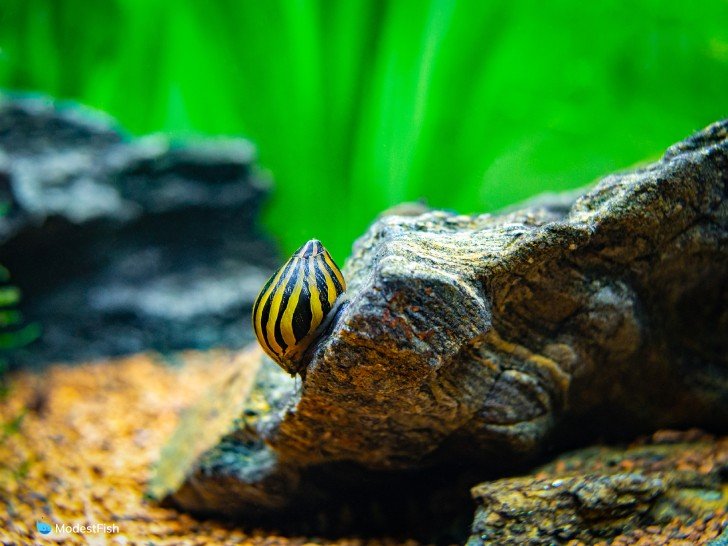
Nerites are the best algae-eating snails in the aquarium trade.
There are many, many different species of nerite. I love all the different colors and patterns on their shells. There are even some species that have little horn-like projections that grow from their shells.
These snails do need water with a high mineral content. Like other invertebrates, they use calcium from the water to build their shells.
Nerites will lay eggs in freshwater, but the eggs will not hatch in freshwater.
The eggs are really the only downside to nerite snails. The snails will deposit bright white eggs all over your rocks and decor and they are VERY hard to scrub off. I resorted to scraping them off with a razor blade, and even that was a helluva job.
41. Mystery Snail (Pomacea bridgesii)
- Size: 2 inches (5 centimeters)
- Minimum tank size: 10 gallon (39 liter)
- Care level: easy
- Temperament: peaceful
- Can be kept together?: yes, but you’re less likely to have unwanted babies if you have only one snail.
- Temperature: 68°-82°F (20°-28°C)
- Diet: omnivore
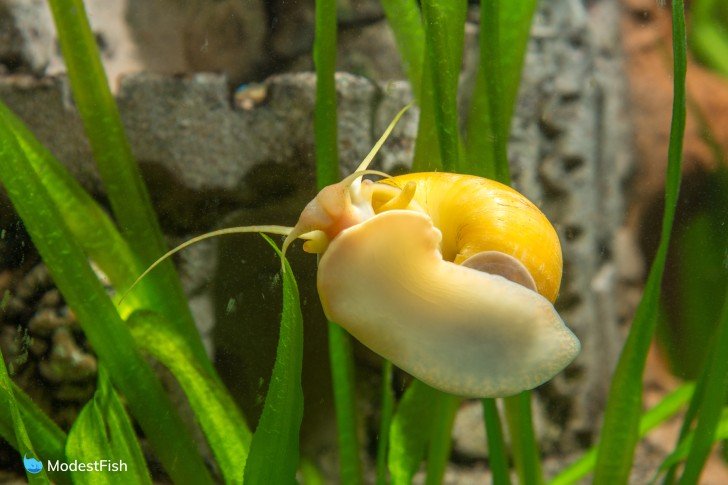
I love mystery snails; I have a ton of them throughout my eight home aquariums.
They’re not the best algae eater, but they definitely help keep it in check, and they do an excellent job of keeping the tank clear of uneaten food.
I love to watch them move along the glass. They look like they’re just hovering and sliding along the surface as if gravity doesn’t apply to them.
This species absolutely will have a ton of babies, but they do grow rather slowly, so you’re not quickly overrun with a horde. I give away extras or sell them to the live fish store.
If you want to avoid extra snails, keep only one mystery snail in your tank. But, be warned, females can hold onto sperm for a very long time. So, your single snail might arrive pregnant.
Which Community Species Will You Pick?
Well, I think I’ve done a pretty thorough job of telling you about all the awesome community fish you can use in your tanks.
Please remember, this is just a basic overview. It’s best to do research about a species before you decide to bring it home.
I love community tanks. I think they are the most interesting kind of aquarium. There’s a variety of fish, occupying different levels of the tank, with lots of different colors and patterns.
There are so many species out there that make great community fish, it’s really awesome.
I hope you find this article helpful.
I wish you and your fish the very best!
